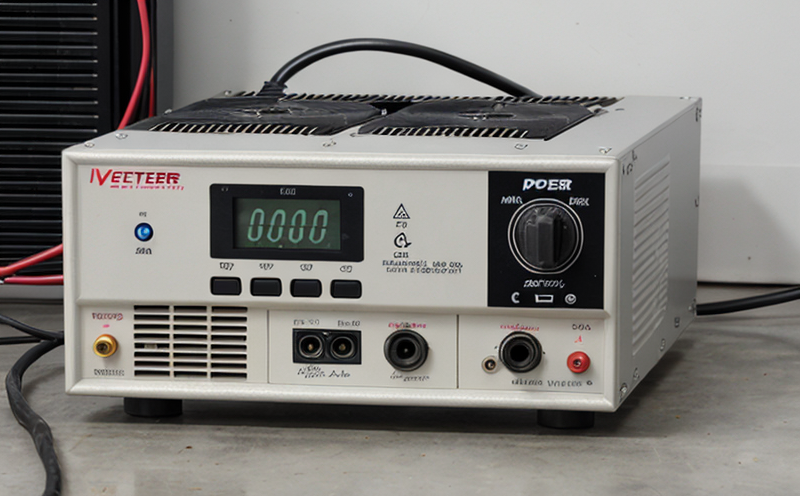Surface Burning Characteristics Test
The Surface Burning Characteristics (SBC) test is a critical procedure designed to evaluate the flammability and flame spread behavior of materials used in electronics, especially those employed in energy systems. This test is particularly important for inverters and power electronics, which are integral components in renewable energy applications such as solar photovoltaic systems and wind turbine installations.
The SBC test provides insights into how a material will behave when exposed to an ignition source under controlled conditions. The primary objective of this testing is to ensure that materials meet stringent safety standards, thereby protecting users from potential hazards associated with fire risks. This service plays a pivotal role in the energy sector by ensuring the reliability and safety of power electronics devices.
During the SBC test, specimens are subjected to specific conditions designed to simulate real-world scenarios where they might come into contact with an ignition source. The testing process includes detailed preparation steps that involve cutting the specimen according to specified dimensions, ensuring a consistent edge for accurate flame spread measurements. Once prepared, the sample is placed in a specialized chamber equipped with a burner that delivers controlled heat and flame.
The SBC test adheres to international standards such as ASTM E648-13, which specifies the procedure for determining the surface burning characteristics of materials used in electrical insulation. Compliance with these standards ensures consistency across different laboratories and fosters trust among stakeholders involved in the renewable energy industry.
- Why Choose This Test:
- To ensure compliance with international safety regulations
- To enhance product reliability by identifying potential fire risks early
The SBC test is a cornerstone of quality assurance processes within the energy sector. It helps manufacturers and suppliers verify that their products meet rigorous flammability requirements, which are essential for protecting end-users from accidental fires.
Compliance with international standards like ASTM E648-13 not only ensures that testing results are credible but also facilitates smoother market entry by meeting regulatory benchmarks. This is particularly important in the rapidly growing renewable energy sector where safety and reliability are paramount.
Scope and Methodology
The scope of the Surface Burning Characteristics test encompasses a comprehensive evaluation of materials used in inverters and power electronics. This includes assessing the flammability, flame spread rate, and smoke production characteristics of these components under controlled laboratory conditions.
The methodology involves several key steps:
- Specimen Preparation: Materials are cut into standardized dimensions to ensure uniformity
- Testing Conditions: Specimens are exposed to a controlled flame source in a specialized chamber
- Data Collection: Flame spread rate, peak heat release rate (PHRR), and smoke density are measured
The testing process adheres strictly to ASTM E648-13, which outlines the specific procedures for conducting this test. By following these internationally recognized guidelines, we ensure that our results are accurate, reproducible, and comparable with other laboratories.
Data obtained from the SBC test provides valuable insights into the fire safety performance of materials used in power electronics devices. These insights are crucial for identifying areas where improvements can be made to enhance product reliability and user safety.
Why Choose This Test
The SBC test is a vital tool for manufacturers and suppliers who aim to ensure product reliability by identifying potential fire risks early on. By choosing this service, you can rest assured that your products meet rigorous safety standards, enhancing user confidence and compliance with regulatory requirements.
- Why Choose This Test:
- To comply with international safety regulations
- To enhance product reliability by identifying potential fire risks early
Selecting the Surface Burning Characteristics test for your materials ensures that they meet the highest standards of safety and performance, making them ideal candidates for use in energy systems.
Environmental and Sustainability Contributions
The Surface Burning Characteristics (SBC) test plays a significant role in promoting sustainability within the renewable energy sector. By ensuring that materials used in inverters and power electronics meet stringent safety standards, this service helps mitigate potential environmental risks associated with fire accidents.
Compliance with international standards like ASTM E648-13 not only ensures product reliability but also contributes to the overall sustainability goals of the industry. When manufacturers adhere to these guidelines, they are better positioned to reduce waste and improve energy efficiency in their products.
- Environmental and Sustainability Contributions:
- Mitigation of fire risks
- Reduction in product waste
The SBC test is an essential component of a broader sustainability strategy. By minimizing the likelihood of fires, this service helps prevent unnecessary losses and supports more efficient energy utilization.
In addition to enhancing safety, the SBC test also contributes to the development of more sustainable materials by identifying those that perform best under challenging conditions. This encourages innovation in material science, leading to advancements that benefit both the environment and consumers alike.





